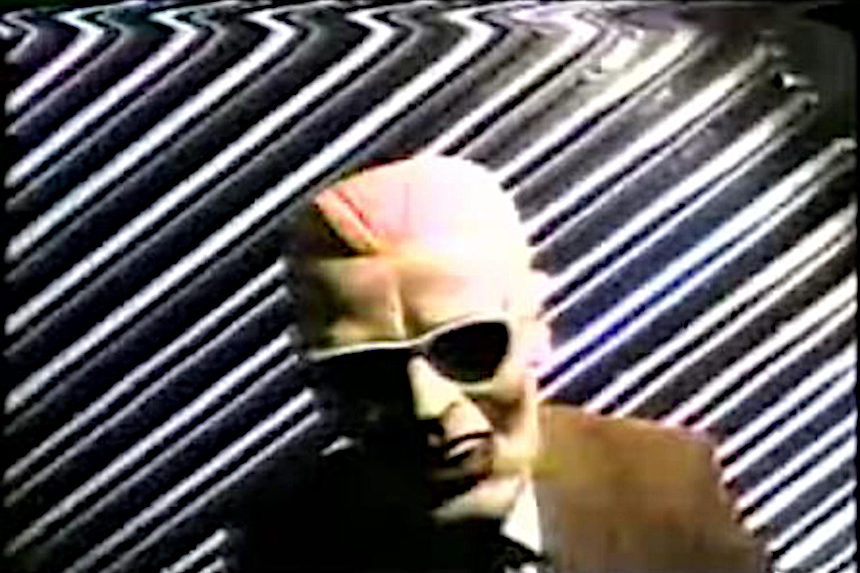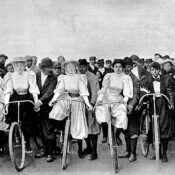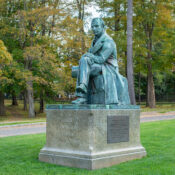Ever since rebellious colonists dressed as Native Americans and vandalized the beverages of the occupying British forces, we’ve been a country that loves elaborate pranks. Some pranks achieve infamy, becoming a kind of Prank Everest that other creators of shenanigans aspire to emulate. We look back at five of the greats, plus one British stand-out (because, you know, the tea).
1. The Max Headroom Intrusion (1987)
Thirty-two years ago this week, Max Headroom appeared on television in Chicago. That wasn’t a terribly unusual event in 1987, as the AI TV host character (played by Matt Frewer) had debuted two years earlier and popped up in everything from music videos to Coke commercials to an ABC TV series. This time, the appearance came via pranksters who hijacked the signals of WGN-TV and WTTW, two Chicago stations. The first intrusion, during The Nine O’Clock News on WGN, featured a person in a Max Headroom mask and lasted for 28 seconds until engineers shut it down by changing the frequency of the transmitter (which was located atop the John Hancock Building).
The signal interruption on WTTW lasted 90 seconds during an episode of Doctor Who, and included all manner of weirdness. The masked Max made reference to Chicago sportscaster Chuck Swirsky, Pepsi, and WGN’s origin as the “World’s Greatest Newspaper.” He also exposed his bottom to be spanked with a flyswatter. It took longer for the engineers to take down the signal, as no one was on duty at the (then) Sears Tower transmitting station at the time.
The intrusion made national news and remains a touchstone in the hacking community. To this day, the perpetrators remain unknown.
2. The War of the Worlds (1938)
The Saturday Evening Post has reported extensively on this one. On October 30, 1938, Orson Welles and company broadcast a radio drama based on the H.G. Wells classic The War of the Worlds. However, the storytelling technique that they used was that of a series of news broadcasts interrupting “regular” music programming so that it sounded like actual news. While reports of actual panic vary, a good chunk of listeners did believe that a Martian invasion was on. As the program reached the end, the New York Police showed up to shut the production down. Welles gave a tongue-in-cheek apology, but the legend would live on. Just two years later, Welles would begin shooting his first feature film, the classic Citizen Kane.
3. The Society for Indecency to Naked Animals (1959)
We’re sorry to report that The Post missed the boat on this one. Alan Abel, a writer and inveterate hoaxster who put together pranks on a grand scale, pitched a story to The Saturday Evening Post that was originally satire about a fictional organization with the slogan “A nude horse is a rude horse.” When the editors rejected it, Abel reworked the story into an elaborate media hoax; he sent a number of press releases out about the Society, a parody of moral panic groups that implored the public to dress and cover nude animals. Abel recruited multi-talented comedy legend Buck Henry to pretend to be G. Clifford Prout, Jr., the fictional head of the equally fictional group. The prank lasted for years, beginning with wide notice during a segment on The Today Show in May of 1959 and hitting a kind of zenith as Henry appeared in a pre-recorded interview package as Prout on The CBS Evening News in 1962. Members of CBS anchor Walter Cronkite’s staff recognized Henry, and the esteemed newsman (at the time a very steamed newsman) called Abel himself to read him the riot act. Time magazine ran a piece on the hoax in 1963, and Abel recounted its origins and spread in his 1966 book, The Great American Hoax.
4. The Great Rose Bowl Hoax (1961)
A story on The Great Rose Bowl Hoax from KRQE
A school attempting to prank the opposing team or their fans during a game is nothing new. A school that isn’t involved in the game, and yet somehow manages to prank both teams AND network television? Now that’s something else. That went down during the 1961 Rose Bowl game between the Washington Huskies and the Minnesota Golden Gophers. The California Institute of Technology is very close to the Rose Bowl, which gave a group of enterprising students (“The Fiendish Fourteen”) the prime opportunity to pull off something brilliant. Future physicist and fantasy author Lyn Hardy pretended to be a reporter and interviewed the Huskies’ head cheerleader to get information about their half-time card-flip, in which the Washington side of the stadium would hold up cards that spelled out HUSKIES. Hardy and company swiped a copy of the instruction sheet from the cheerleaders, who were staying at the Caltech dorms, and then replaced the old sheets with their reworked copies. At halftime, when the Washington cheerleaders called for the cards to be raised, the cards showed the other side of the stadium, and 30 million viewers at home, one word: CALTECH.
The effort has been called the greatest college prank of all time. It has inspired similar efforts; in 1984, Caltech students rigged the scoreboard to show Caltech beating MIT, although the game was being played by UCLA and Illinois. Yale pulled off a similar prank in 2004, tricking a Harvard student section into holding up signs that spelled out “We Suck.” The pranksters also registered harvardsucks.org and posted a behind-the-scenes video of how they made it work.
5. MIT Creates Building-Sized Tetris (2012)
The Green Building, designed by Araldo Cossutta and I. M. Pei, is an iconic structure on the campus of the Massachusetts Institute of Technology. The building’s grid-like appearance invited the Holy Grail of hacks: could the building be turned into a game of Tetris? After a brief attempt in 2011, hackers installed wirelessly controlled LED lights in all the windows above the first floor that were controlled by a unit in front of the building. The effort, achieved on Campus Preview Weekend, allowed prospective students to play building-sized Tetris along with their future classmates.
Honourable Mention. Big Ben Goes Digital (1980)
From across the pond comes an April Fool’s Day classic. On April 1, 1980, the BBC broke news that iconic Big Ben was going to be converted into a digital clock. The BBC Japanese service went so far as to say that the clock hands would be sold to the first four listeners that called in with an offer. Of course, people were properly outraged. The 1980 bit has been revisited again and again over the years, with publications like The International Business Times putting their own spin on the gag.
Featured image: Max Headroom broadcast signal intrusion (Alamy).
Become a Saturday Evening Post member and enjoy unlimited access. Subscribe now



